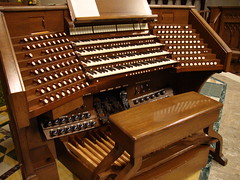"Toccata and Fugue in D Minor" is one of the world's notable Bach organ pieces.
The pipe organ is a musical instrument that produces sound by driving pressurized air (called wind) through pipes selected via a keyboard.
Each organ pipe produces a single pitch.
Most organs have multiple ranks of pipes of differing timbre, pitch and loudness that the player can employ singly or in combination through the use of controls called stops.
A pipe organ has one or more keyboards (called manuals) played by the hands, and a pedalboard played by the feet, each of which has its own group of stops.
The organ's continuous supply of wind allows it to sustain notes for as long as the corresponding keys are depressed, unlike the piano and harpsichord whose sound begins to decay immediately after attack.
The smallest portable pipe organs may have only one or two dozen pipes and one manual; the largest may have over 20,000 pipes and seven manuals.[2]
The origins of the pipe organ can be traced back to the hydraulis in Ancient Greece in the 3rd century BC,[3] in which the wind supply was created with water pressure.
Subscribe to:
Post Comments (Atom)





No comments:
Post a Comment